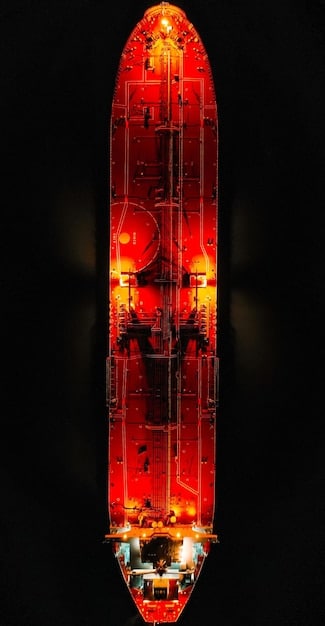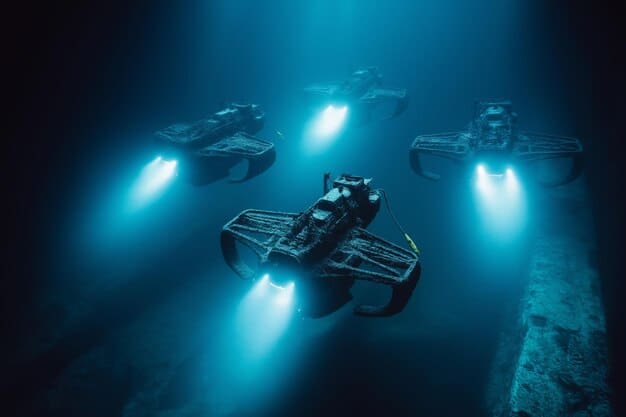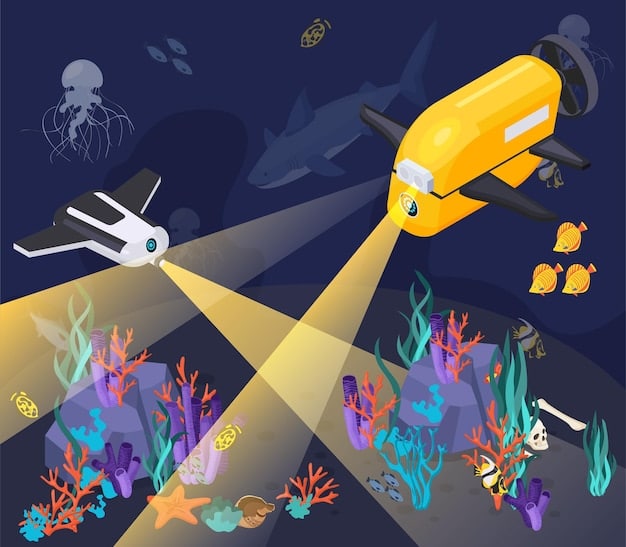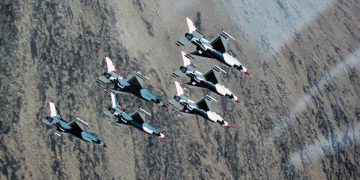Unmanned Underwater Vehicles: Navy’s Cutting-Edge Subsea Tech

Unmanned Underwater Vehicles (UUVs) represent a pivotal advancement in naval technology, providing enhanced subsea capabilities for reconnaissance, surveillance, mine countermeasures, and oceanographic research, thereby increasing operational effectiveness and minimizing risks to personnel.
The U.S. Navy is rapidly integrating Unmanned Underwater Vehicles: Exploring the Navy’s Newest Subsea Capabilities to revolutionize underwater operations. These advanced technologies are reshaping naval strategies, delivering unmatched potential in various critical missions.
Understanding Unmanned Underwater Vehicles
Unmanned Underwater Vehicles (UUVs) are essentially robots designed to operate underwater without a human presence. They are equipped with various sensors, navigation systems, and power sources to perform specific tasks autonomously or remotely.
These vehicles enhance naval capabilities in areas that are too dangerous, difficult, or costly for traditional manned operations.
Types of UUVs
UUVs are classified based on size, endurance, and operational capabilities. Understanding these classifications is crucial to appreciating their diverse applications.
- Autonomous Underwater Vehicles (AUVs): Operate independently, following pre-programmed missions without real-time human control.
- Remotely Operated Vehicles (ROVs): Controlled by a human operator via an umbilical cable, allowing for real-time intervention.
- Hybrid UUVs: Combine features of both AUVs and ROVs, offering flexibility in mission execution.
Each type serves unique purposes, from long-range reconnaissance to detailed underwater inspections.
Advanced Capabilities of Navy UUVs
The Navy’s UUVs are equipped with cutting-edge technology. These advanced capabilities expand operational effectiveness and precision.
These vehicles can execute complex missions such as intelligence gathering, surveillance, and reconnaissance in contested environments.

Sensor Technologies
UUVs deploy a wide range of sensors to gather critical data. These tools deliver detailed insights into the underwater landscape.
- High-Resolution Sonar: Mapping the seafloor and detecting underwater objects with exceptional clarity.
- Optical Cameras: Providing visual inspection and documentation of submerged structures and environments.
- Environmental Sensors: Monitoring temperature, salinity, and other parameters for oceanographic research.
The use of these sensors enables accurate data collection for operational and scientific purposes.
Mine Countermeasures (MCM)
One of the most critical roles of UUVs is mine countermeasures. By autonomously detecting and neutralizing mines, UUVs significantly reduce risks to naval personnel and assets.
This application minimizes the need for manned vessels in dangerous minefields, enhancing the safety and efficiency of MCM operations.
UUVs in Mine Detection
UUVs use advanced sonar and sensors to identify mines in challenging underwater conditions.
- Side-Scan Sonar: Wide-area search capability to locate potential mine-like objects.
- Synthetic Aperture Sonar (SAS): High-resolution imaging for detailed mine classification.
The ability to autonomously navigate and identify mines makes UUVs invaluable for MCM missions.
Intelligence, Surveillance, and Reconnaissance (ISR)
UUVs are crucial in modern ISR operations. Their stealth and endurance allow persistent monitoring of strategic areas without risking human lives.
They can operate in sensitive environments for extended periods, collecting intelligence for critical decision-making.

Long-Range Missions
UUVs can cover vast areas for ISR missions, maximizing surveillance coverage.
Their covert capabilities enable stealthy data collection, providing a strategic advantage in security operations.
Oceanographic Research Applications
In addition to military roles, UUVs contribute significantly to oceanographic research. They provide crucial data on underwater environments, climate change, and marine ecosystems.
Gathering detailed oceanographic data helps scientists understand complex underwater phenomena for scientific advancement and environmental preservation.
Environmental Monitoring
UUVs are essential for monitoring ocean health and climate change impacts.
- Temperature Profiles: Monitoring changes in ocean temperature to understand climate patterns.
- Salinity Levels: Tracking salinity distribution to assess water mass dynamics and their effects on marine life.
- Pollution Monitoring: Identifying and quantifying pollutants in sensitive marine environments.
These studies enable more effective conservation efforts.
Future Trends in Navy UUV Development
The future of Navy UUVs involves further advancements in autonomy, endurance, and sensor capabilities. These innovations will continue to shape naval strategies and enhance subsea operations.
Ongoing research focuses on improving UUV resilience and performance in harsh underwater conditions.
Advancements in Autonomy and AI
Artificial intelligence (AI) is playing an increasing role in UUV operations, enabling more autonomous and adaptable systems.
- Real-Time Decision Making: UUVs can now make decisions based on sensor data, adapting missions as needed.
- Improved Navigation: Advanced algorithms enhance navigation accuracy in complex underwater environments.
AI integration drives the development of next-generation unmanned underwater vehicles.
| Key Point | Brief Description |
|---|---|
| 🛡️ Mine Countermeasures | UUVs detect and neutralize mines to reduce danger to naval personnel. |
| 🛰️ ISR Operations | Provide persistent monitoring and intelligence gathering in strategic areas. |
| 🌊 Oceanographic Research | Collect data on underwater environments to understand climate change and marine ecosystems. |
| 🤖 AI Integration | Advances in autonomy and AI enhance UUVs’ decision-making capabilities. |
Frequently Asked Questions
▼
UUVs are robotic vehicles that operate underwater without a human presence, equipped with sensors and navigation systems for various tasks from data collection to reconnaissance.
▼
UUVs use sonar and sensors to detect and neutralize mines, reducing the risk to naval personnel and manned vessels in dangerous minefield environments.
▼
Navy UUVs use high-resolution sonar, optical cameras, and environmental sensors to map the seafloor, inspect structures, and monitor ocean conditions accurately.
▼
UUVs collect critical oceanographic data, such as temperature and salinity levels. Also, they monitor pollution for environmental research and conservation efforts.
▼
AI enhances UUV capabilities by enabling real-time decision-making and improving navigation accuracy, which allows adaptation during underwater missions.
Conclusion
Unmanned Underwater Vehicles: Exploring the Navy’s Newest Subsea Capabilities are revolutionizing naval operations, offering enhanced capabilities across various critical missions. From mine countermeasures to oceanographic research, these advanced technologies provide a safer and more efficient means of exploring and understanding the subsea environment. The ongoing advancements in autonomy and sensor technologies promise an even greater role for UUVs in the future of naval strategy and ocean exploration.





